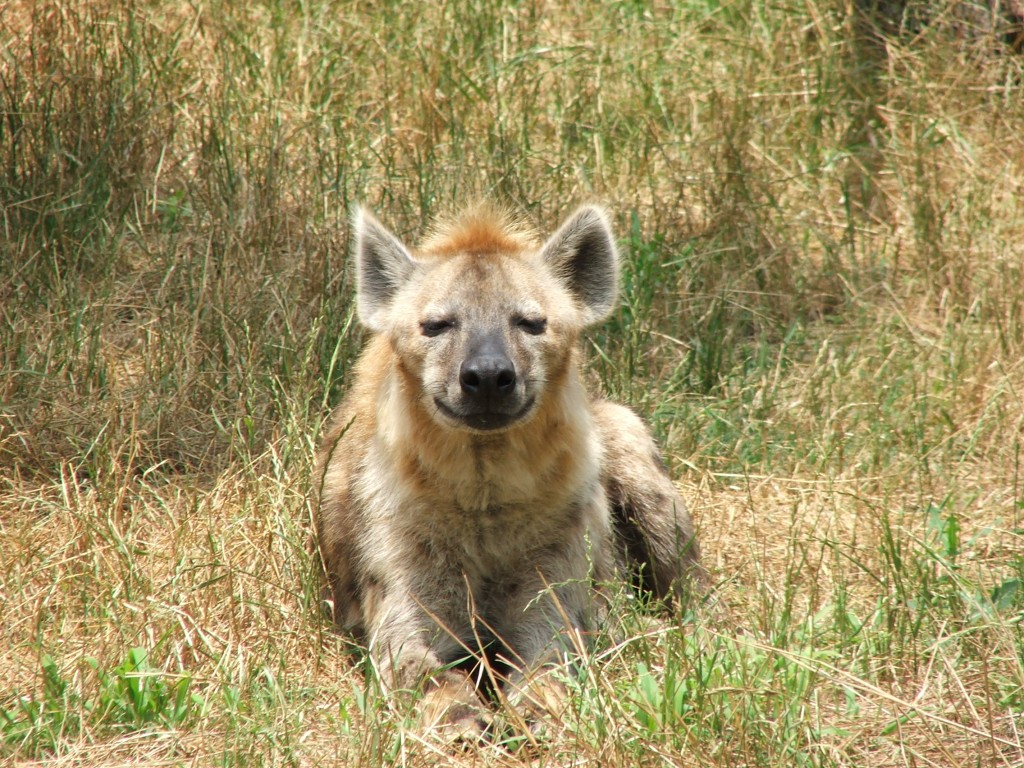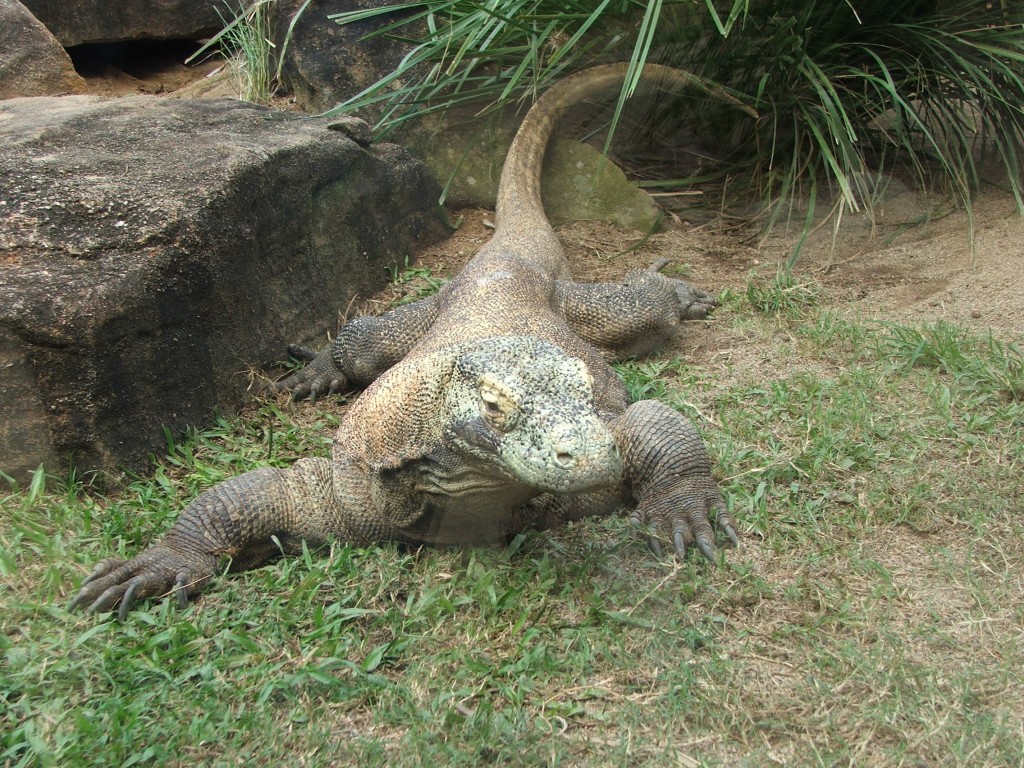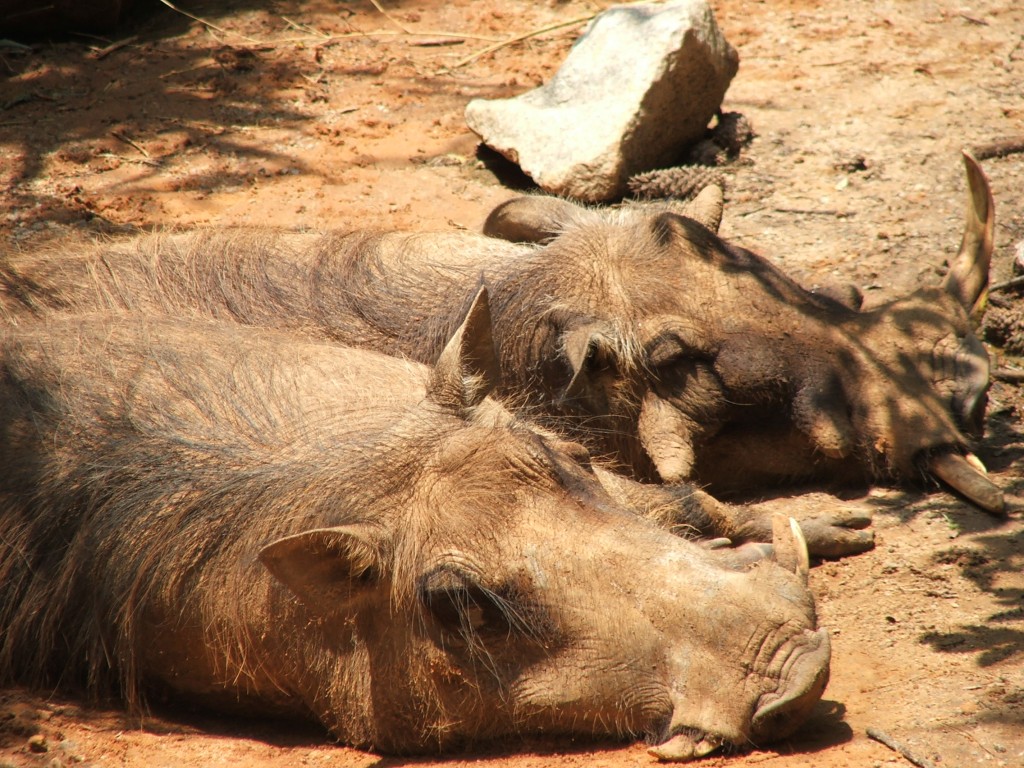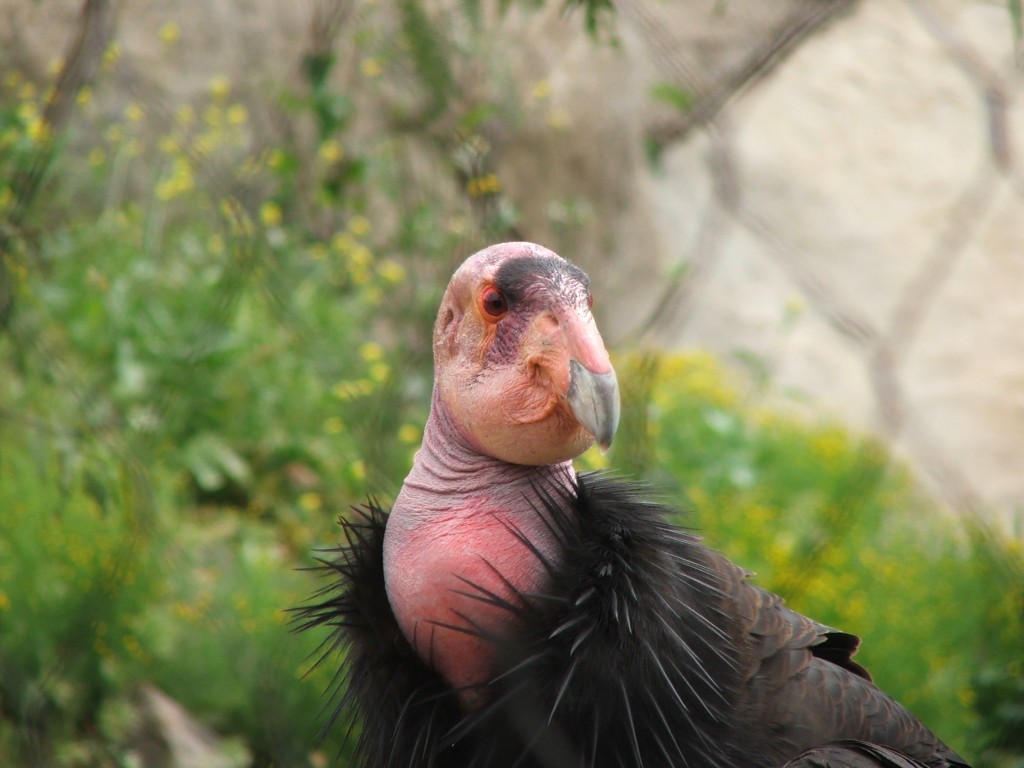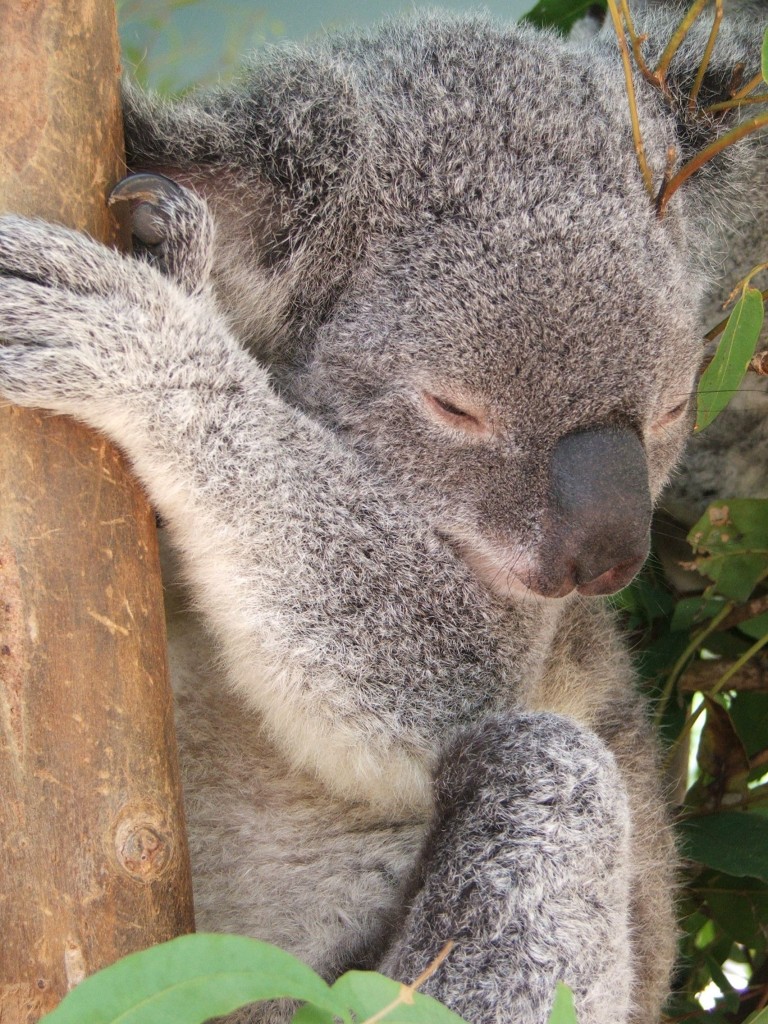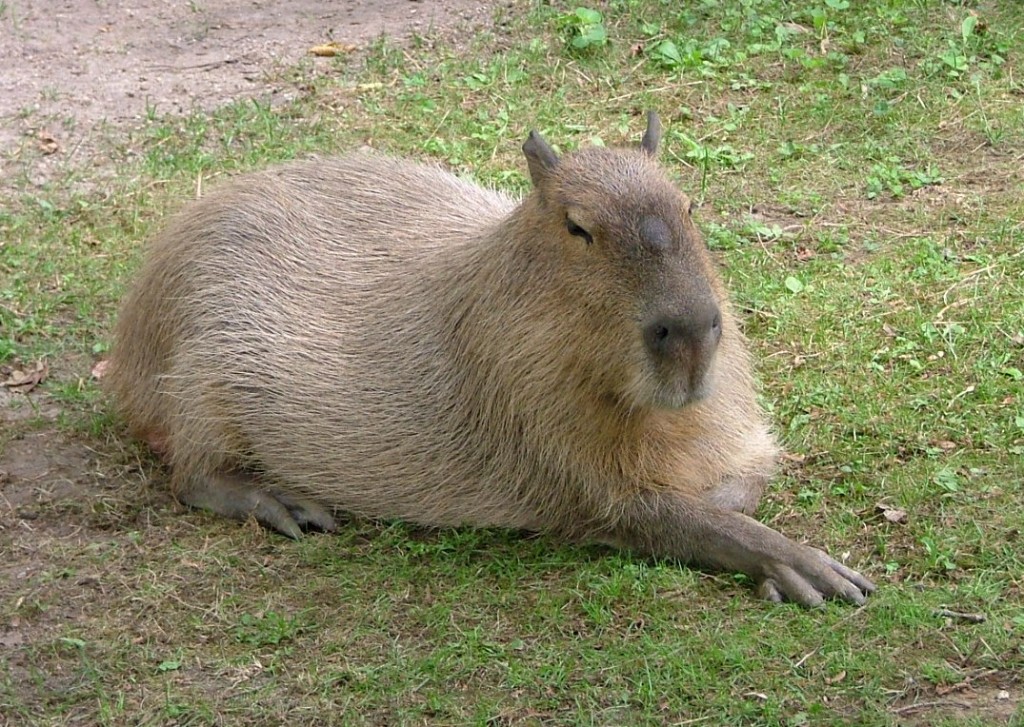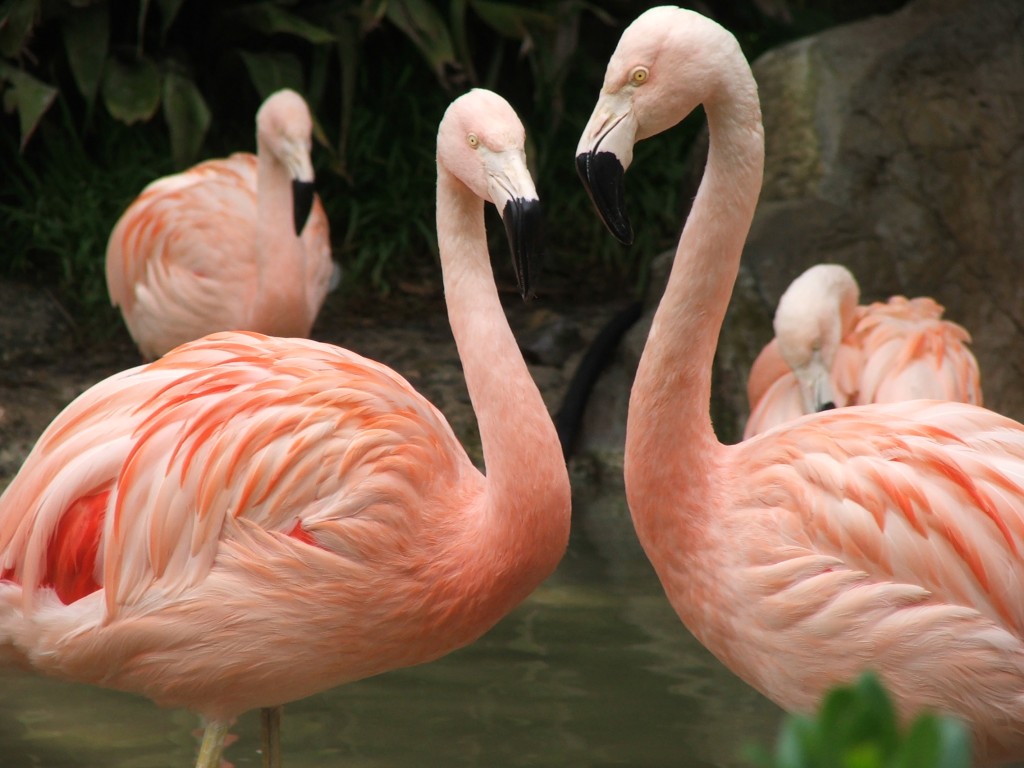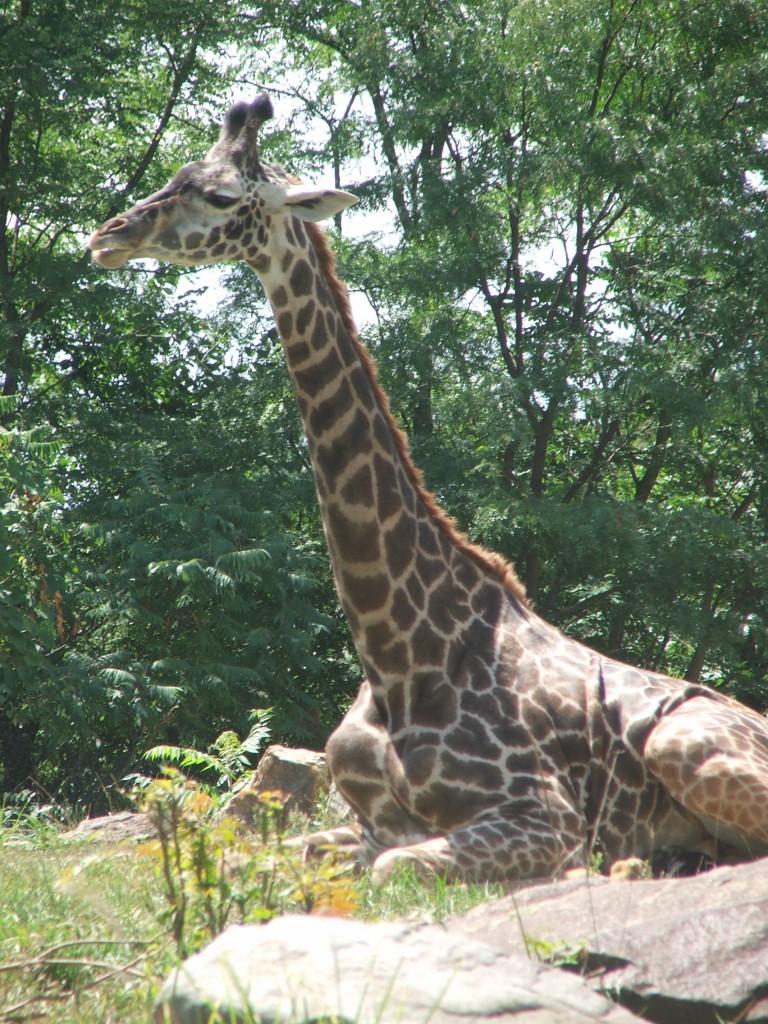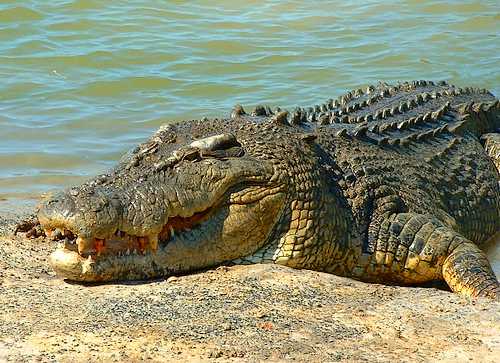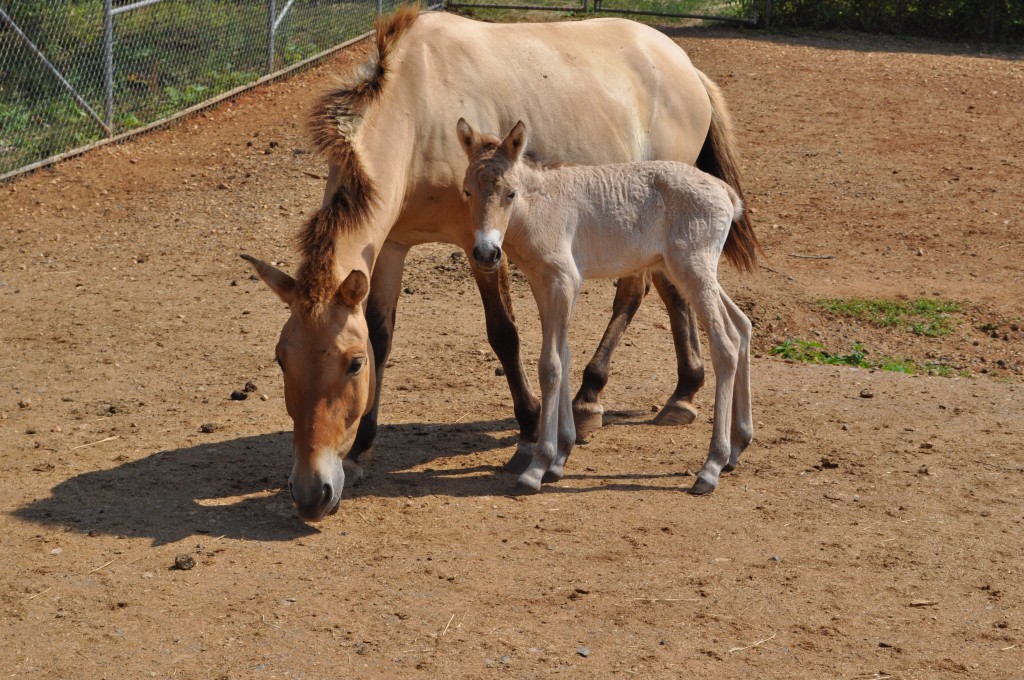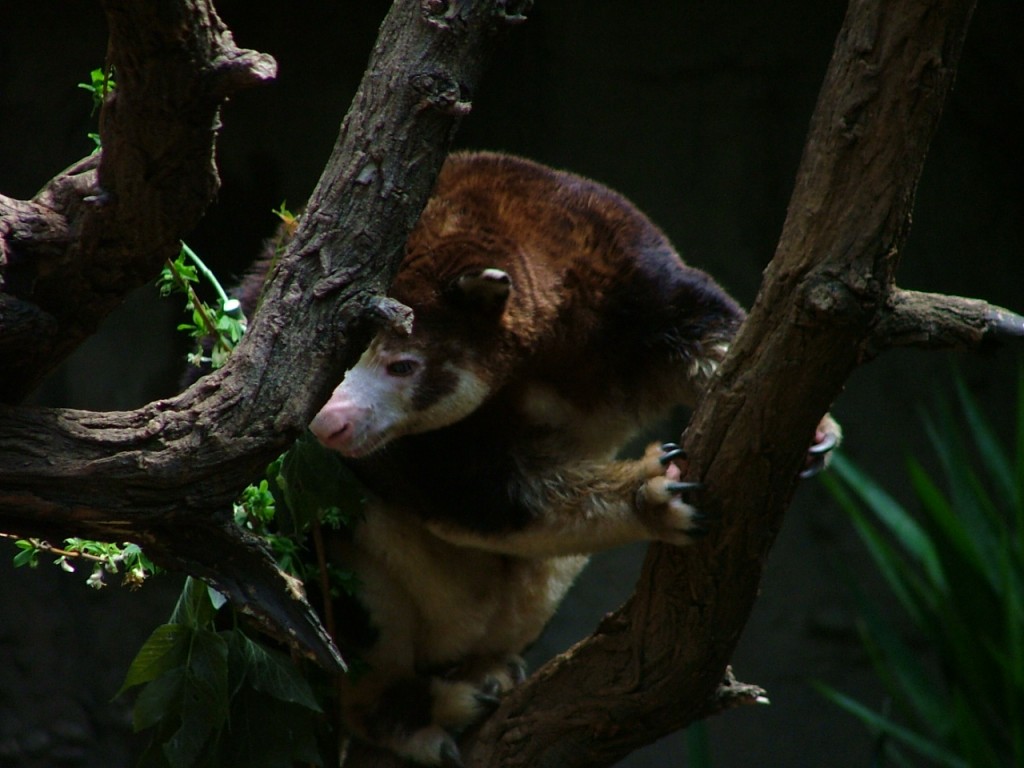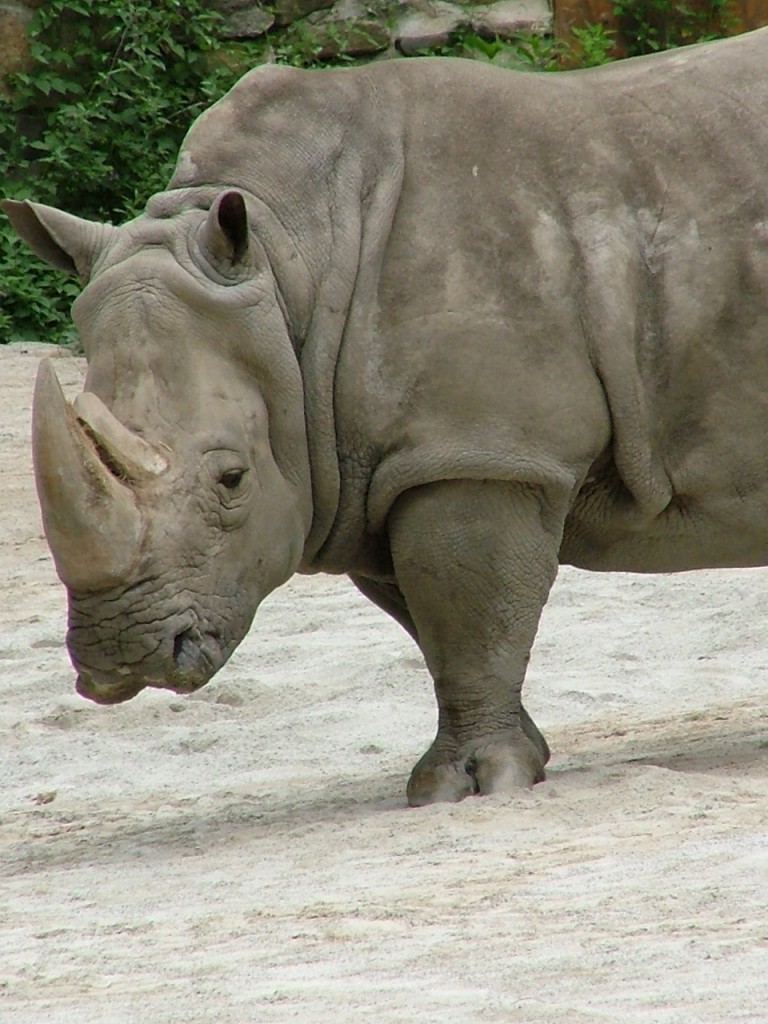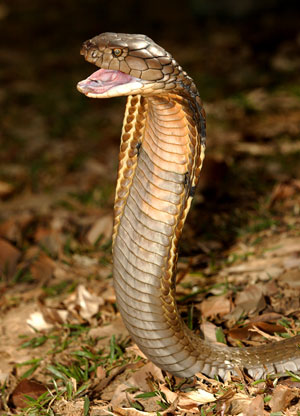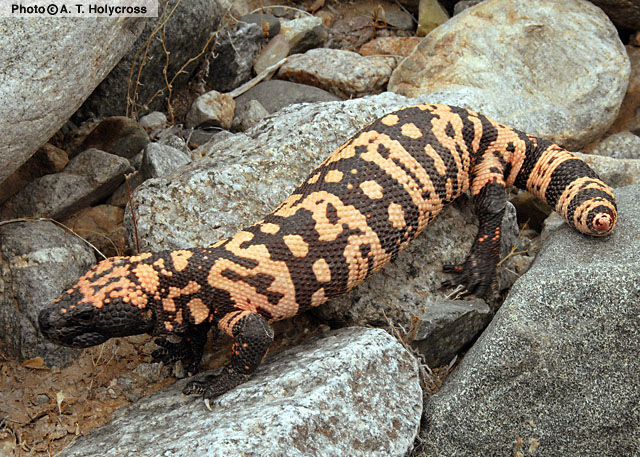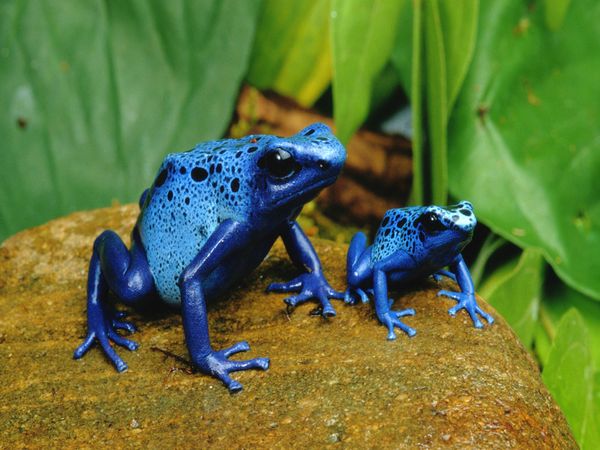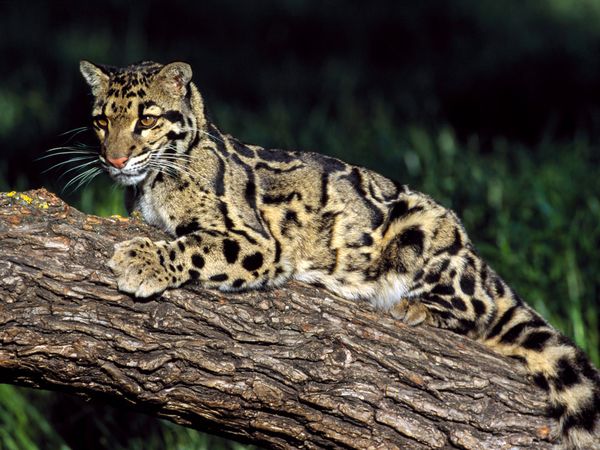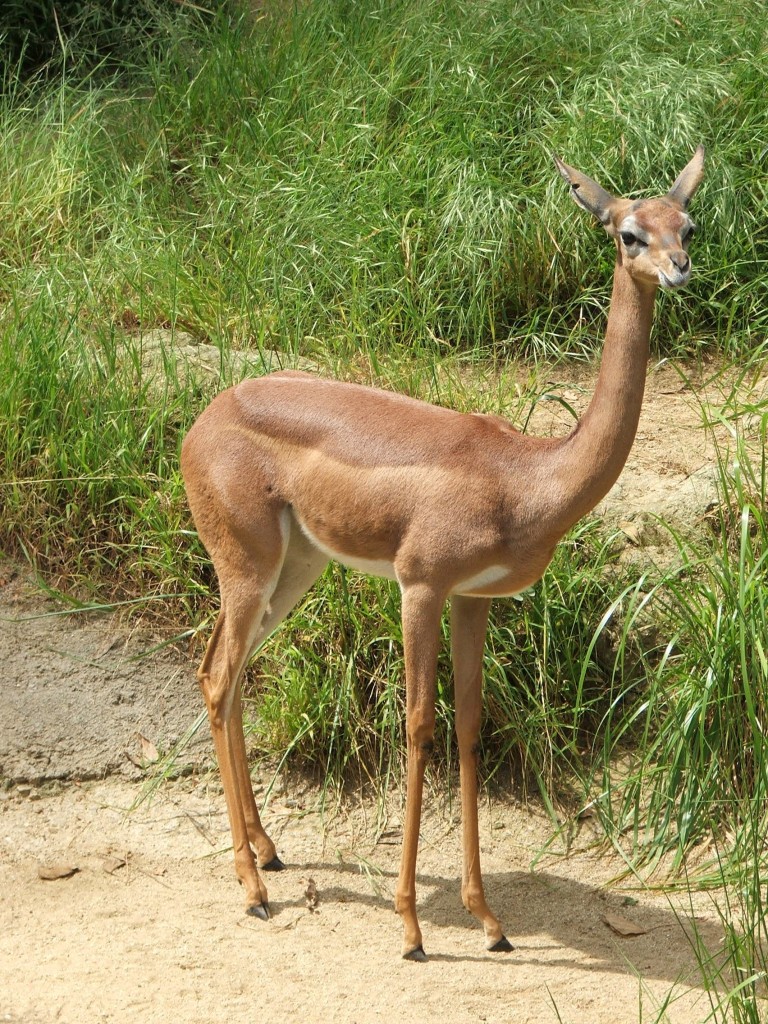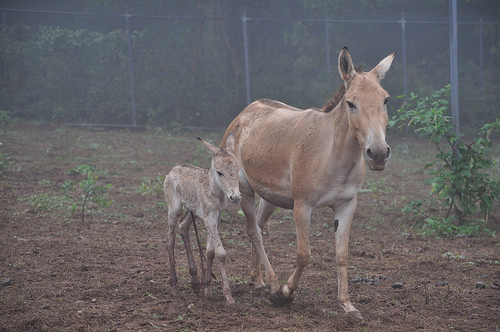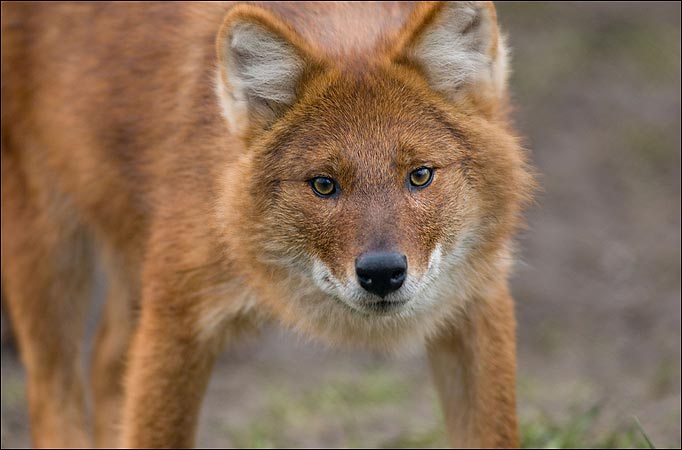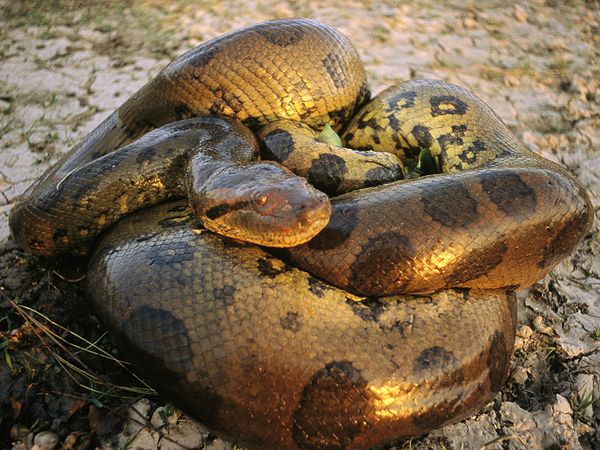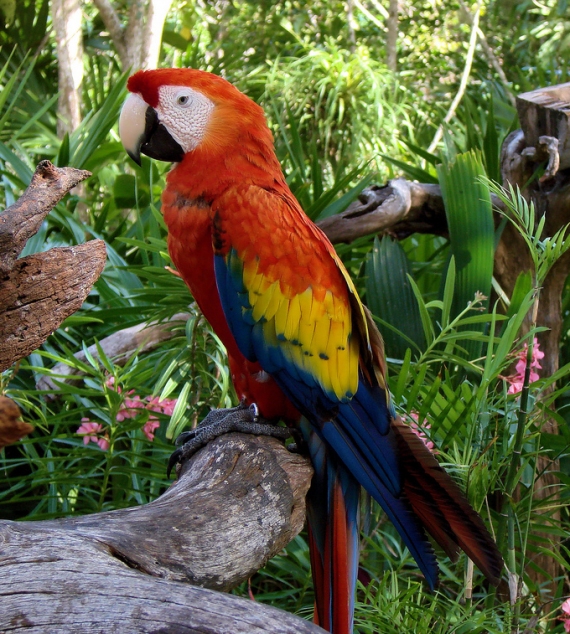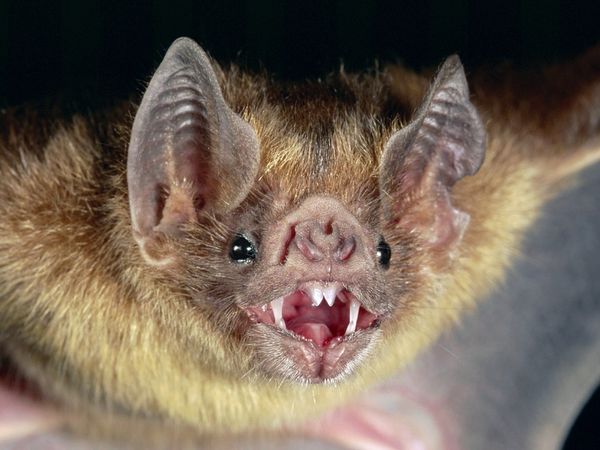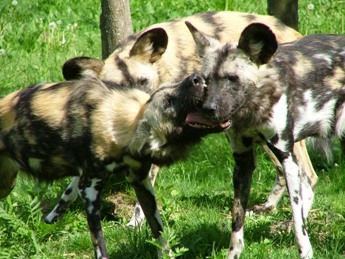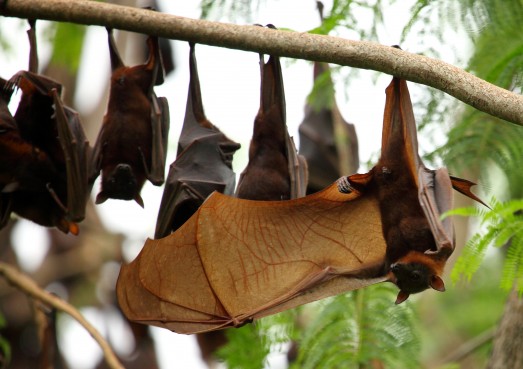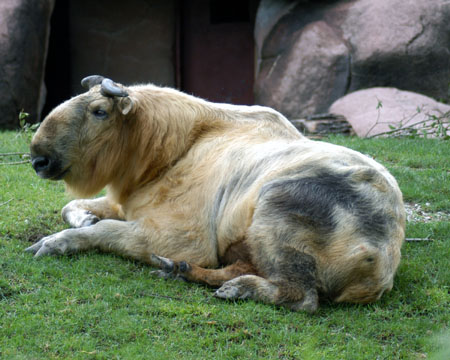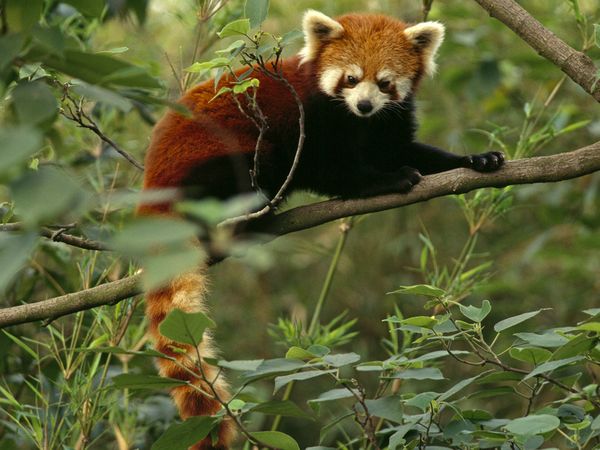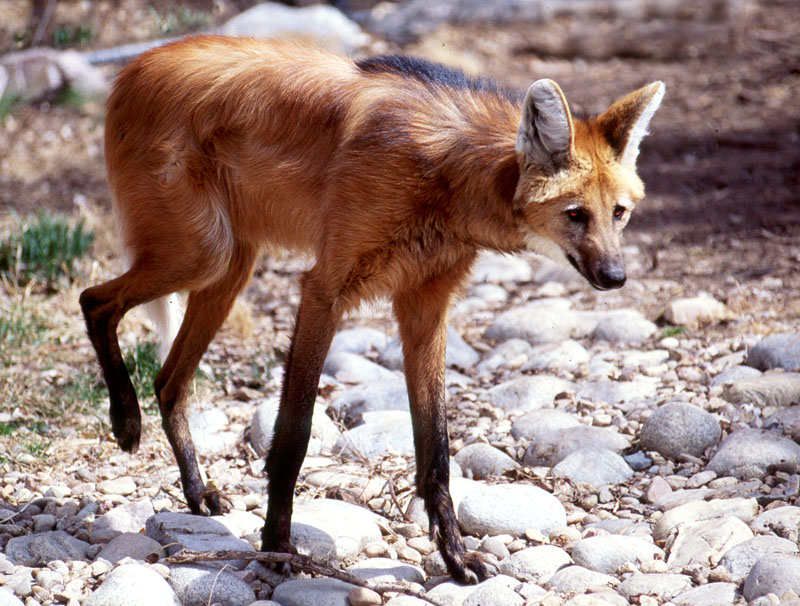Spotted Hyena
Crocuta crocuta
- There are three species of hyena in Africa
- In ancient Egypt hyenas were domesticated and raised for food.
- Female hyenas are dominant over the males.
- Hyena cubs are born with their eyes open!
- Hyenas can go for several days without water.
- During one meal a spotted hyena can eat up to one third of its body weight.
- Although they look similar, Hyena are not related to dogs.
Komodo Dragon
Varanus komodoensis
- The endangered komodo dragon is the largest lizard in the world weighing up to 150 kg (330 lbs) and 3 m (10 ft) long.
- Komodo dragons can only be found on a few volcanic Indonesian islands of the lesser Sunda group including Komodo Island; Komodo Island is only 35 km (22 mi) wide.
- Komodo dragons can eat up to 80% of its own body weight in a single meal eating all but 12% of its prey!
- The saliva of the Komodo dragon contains 50 strains of bacteria and in 2009 it was discovered that it also contains a toxic venom.
- Komodo dragons can run up to 11 mph for short distances.
- The komodo dragon can live 30 + years.
- Although they look similar, Hyena are not related to dogs.
Warthog
Phacochoerus africanus
- The warthogs “warts” aren’t really warts at all, but simply thick skin growths.
- Male warthogs have the most obvious “warts” on their; the warts actually act as cushions to protect males from hits given by other males during breeding season.
- Like all pigs, warthogs are omnivorous eating everything from roots to rotting animals carcasses.
- Warthogs have very long legs, compared to other members of the swine family, which allows them to run at speeds reaching 55 km/hr (34 mi/hr) to evade predators such as lion cheetah, leopard, hyena, and eagles.
- Like elephants, a group of warthogs are made up of only females (sows) and their young (piglets); males (boars) are solitary.
- Warthogs do not dig their own burrows to live and raise young; instead, they use natural burrows or abandoned aardvark holes.
- Warthogs have a life span of 12 to 18 years, and can weigh 50 to 150 kg (110 to 330 lb) depending on gender.
California Condor
Gymnogyps californianus
- Condors can weigh 7.7 to 13 kg (17 to 29 lb), have a wingspan up to 3 m (9 ft), and can live up to 60 years!
- Condors are nature’s cleanup crew. Because they are vultures, Condors eat the flesh of dead animals, carrion.
- The Condor’s featherless head allows them to stay clean by keeping bits of rotting flesh from sticking to them. Contrary to what people think, Condors are very clean, spending hours a day cleaning and preening their feathers.
- Condors make their homes in crevices and caves along rocky cliffs; no nest is actually constructed wherein eggs are simply laid and incubated on rock.
- While flying, Condors utilize thermal air currents that allow them to reach altitudes of 4,600 m (15,000 ft) and speeds of 88 km/hr (55 mi/hr).
- After wonderful conservation efforts, Condor numbers in the wild have increased from just 22 birds in 1982 to 399 individuals in 2011.
- Condors survival is still threatened by habitat destruction, poaching and lead poisoning from buckshot found in the dead animals they eat.
Koala
Phascolarctos cinereus
- Although commonly referred to as the koala bear, the koala is not a bear at all. In fact, the koala is a marsupial and is closely related to the kangaroo and wombat.
- Koala is an Aboriginal word meaning “no drink.” Koalas rarely drink; they get all of the moisture they need in their eucalyptus leaves.
- Eucalyptus leaves are the main staple of the koala diet; the koala can eat up to 1 kg (2.2 lb) of leaves every day.
- Koalas are only found in Eastern Australia.
- Koalas sleep up to 18 hours and day and can live up to 20 years.
Capybara
Hydrochoerus hydrochaeris
- The capybara is the largest rodent in the world weighing up to 45 kg (100 lb).
- Being a semi-aquatic rodent, the capybaras are great divers capable of holding their breath for up to 5 minutes.
- The capybara can be found throughout South America including Colombia, Ecuador, Bolivia, Venezuela, Brazil, Argentina, Guyana, French Guiana, Uruguay, Peru, and Paraguay.
- Capybaras are herbivores feeding on aquatic plants, grasses, and fruit.
- Although large in size, the capybara has quite a few predators; the capybara is a favorite prey item for jaguar, ocelot, puma, eagle, caiman, and anaconda.
Flamingo
Phoenicopterus
- The flamingos beautiful pink color comes from the carotenoid pigment in the algae and small crustaceans that they eat.
- There are six species of flamingos that can be found in the Americas, India, Southwest Asia, and parts of Africa.
- The flamingo has a very unique curved bill that helps them trap shrimp and other small creatures for food. The flamingo holds its bill upside down filtering water through the front collecting small food particles via briny plates called lamellae.
- Similar to pigeons, flamingos feed their newly hatched chicks a secretion high in fat and protein from the crop called “crop milk”. Both parents can produce crop milk.
- In East Africa, the lesser flamingo can be found in flocks of over 1 million individuals.
Giraffe
Giraffa camelopardalis
- Depending on gender, giraffe can weigh between 830 to 1,200 kg (1,800 to 2,600 lb) and reach heights of 4.3 to 5.3 m (14 to 17 ft).
- The giraffe and the okapi are the only two species in the giraffidae family.
- Currently, there are 9 subspecies of giraffe; subspecies are identified by unique coat patterns.
- The giraffe’s almost 2.2 m (7 ft) long neck is comprised of elongated cervical vertebrae rather than the addition of more vertebrae.
- Giraffe gestation, or pregnancy, lasts for ~15 months and results in the birth of a calf that is 2 m (6 ft) tall.
Saltwater Crocodile
Crocodylus porosus
- The saltwater crocodile is the largest of the 23 species of crocodilians reaching lengths greater than 5 m (18 ft) and weighing over 450 kg (1000 lbs). However, it is not uncommon to find saltwater crocodiles as long as 7 m (23 feet) and weighing over 1,000 kg (2,200 lbs)!
- The saltwater crocodile can not only be found in brackish and freshwater areas of eastern India, Southeast Asia and Northern Australia, but can in the ocean. Saltwater crocodile are amazing swimmers and have been documented swimming and hunting over 100 miles of the coast in the middle of the ocean.
- The saltwater crocodile, or salty, has an average lifespan of 70 years in the wild.
- As a top apex predator there isn’t too much that a saltwater crocodile cannot eat; menu items include water buffalo, wild boar, and sharks.
- A saltwater crocodile has 3,000 lbs per square inch of jaw pressure.
Przewalski’s Horse
Equus caballus przewalskii
- The Przewalski’s horse is native to Mongolia and is considered the last remaining breed of wild horse in the world.
- Once considered extinct in the wild, the Przewalski’s horse now has a wild population of 250 thanks to captive breeding and reintroduction programs.
- Compared to domesticated horses, the Przewalski’s horse would be considered a pony standing 12 to 14 hands or 122 to 142 cm (48 to 56 in) at the shoulder.
- The survival of the Przewalski’s horse is under continual threat due to habitat loss and hunting.
- Although in the Equus family, the Przewalski’s horse has 66 chromosomes, two more than the domestic horse.
Matschie’s Tree Kangaroo
Dendrolagus matschiei
- Matschie’s tree kangaroo is one of 14 different species of tree kangaroo that can be found in the rain forests of Northern Australia, West Papua, and Papua New Guinea.
- The Matschie’s tree kangaroo is an arboreal herbivore with a main diet consisting of leaves, flowers, fruit, and bark.
- Unlike their land dwelling cousins, the tree kangaroo’s arms and legs are the same length; this anatomical difference helps them navigate through the trees.
- Matschie’s tree kangaroo is mostly solitary with the exception of males and females interacting for breeding opportunities.
- Adult Matschie’s tree kangaroos can weigh 7 to 10 kg (15 to 22 lbs) and reach heights of 50 to 81 cm (20 to 32 in).
White Rhinoceros
Ceratotherium simum
- The white rhino is not actually white, but the same color as the black rhino, gray. The words white and black are mistranslations of the original Dutch words used to describe them. White and Black are actually in reference to the shape of the mouth, particularly the upper lip. The white rhino has a wide, squared mouth compared to the pointed upper lip of the black rhino.
- There are a total of five rhino species: White, Black, Indian, Javan, and Sumatran. In addition, there are two subspecies of white rhino found in its home range in Africa: Southern and Northern.
- The rhino’s horn is made of keratin; the exact same protein that makes up hair, fingernails, and animal hooves. In China, Hong Kong, Taiwan, and Singapore the Rhino’s horn is used in traditional medicine and is thought to hold magical healing powers; these claims are false.
- Regardless of species, the biggest threat to the rhino is poaching due to the high demand for rhino horn.
- A white rhino pregnancy lasts for 16 months.
King Cobra
Ophiophagus hannah
- The King cobra is the world’s longest venomous snake reaching more than 5.6 m (18.5 ft) in length and up to 9 kg (20 lbs) in weight.
- As its Latin name Ophiophagus implies, the main diet of the King cobra is snakes. The King cobra has been known to eat ratsnakes, pythons, and even other venomous snakes including kraits, cobras, and smaller King cobras.
- The King cobra can be found throughout forests in India, southern China, Southeast Asia, Philippines, and Indonesia.
- The venom of a King cobra is a neurotoxin meaning it attacks you nervous system. A single bite can release two-tenths of a fluid ounce of venom that has enough toxicity to kill 20 humans.
- Probably the most recognizable snake in the world, when feeling threatened, the King Cobra will flatten it’s neck out forming a hood and rise up 2-3 feet off the ground.
Gila Monster
Heloderma suspectum
- The Gila monster is a species of venomous lizard that lives in the southwestern United States and northwestern Mexico.
- The diet of the Gila monster is quite diverse including bird eggs, small birds and mammals, frogs, lizards, insects, and carrion.
- Although the venom of the Gila monster is a neurotoxin it is not extremely potent; no human fatalities have been recorded in almost 100 years.
- Gila monsters reach a maximum size of 50 cm (20 in) in length and 1.8 kg (4 lb) in weight.
- Populations of Gila monsters are being threatened due to a loss of habitat due to human encroahment.
Poison Dart Frog
Dendrobatidae Family
- Although they average only 2.5 cm (1 in) in length poison dart frogs are considered to be one of the most toxic creatures on Earth. The golden poison dart frog has enough toxins in its skin secretions to kill over 20,000 mice.
- It is the bright colors of poison dart frogs that act as a warning to possible predators that they are poisonous.
- Poison dart frogs can be found in tropical rainforests throughout Central and Latin America.
- The lipophilic alkaloid toxins that are secreted through the poison dart frogs skin actually comes from the ants, centipedes, and mites they eat. Captive bred poison dart frogs fed a diet of crickets do not secrete any toxins.
- The majority of the over 100 species of poison dart frog are now considered endangered due to habitat loss and infection from the deadly chytrid fungus.
Clouded Leopard
Neofelis nebulosa
- The Clouded leopard can be found throughout Southeast Asia and into China, as well as in the foothills of the Himalayans.
- Although small compared to other wild cats, 25 to 40 cm (9.8 to 16 in) tall and 15 to 23 kilograms (33-51 lb), the clouded leopard have the longest canine teeth of any living felid at 5.1 cm (2 in) long.
- An incredible hunter in both the trees and on the ground, the clouded leopard preys on deer, pigs, monkeys, civets, birds, porcupines, and domestic livestock.
- Clouded leopards are accomplished climbers having been documented as capable of hanging upside down from tree branches.
- The clouded leopard status in the wild is considered vulnerable due the high demand of their beautifully pattern pelts and the deforestation of their habitat.
Gerenuk
Litocranius walleri
- The Gerenuk is a species of antelope indigenous to dry scrub land and steppe in East Africa.
- The gerenuk has a unique way of feeding as it stretches its extremely long neck out while standing on its back legs to reach low tree branches.
- A desert-adapted species, the gerenuk can survive long periods without water.
- The main predators of the gerenuk are cheetah, lion, leopard, wild dog, jackals, and humans.
- The average lifespan of a wild gerenuk is eight years.
Onager
Equus hemionus
- The onager is a subspecies of Asiatic wild ass native to the deserts of Syria, Iran, Pakistan, India, Israel, and Tibet.
- Onagers inhabit a semi-desert environment; summer temperatures reach 49 degrees Celsius (120 degrees Fahrenheit).
- The onager is a very thrifty browser eating low-growing plants and grasses, woody vegetation, and even salty soil during times when food is sparse.
- Today only a few hundred onager exist in the wild; the onager is classified as an endangered species.
- The biggest threats to onagers in the wild are poaching for their meat and skin and loss of habitat in home ranges.
Dhole
Cuon alpinus
- The dhole, also known as the Asiatic dog, travels in packs of 5 to 12 members.
- The dhole communicates to pack mates via a large variety of sounds; the dhole can whistle, scream, mew, and even cluck.
- Hunting in packs, dholes can catch large prey items that are up to 10 times their own body. The diet of the dhole consists of ibex, mountain sheep, deer species, rodents, rabbits, turtles, berries, bugs, lizards, and wild pigs.
- Dhole packs maintain large territories up to 88 square kilometers (34 square miles).
- Disease, canine distemper and rabies, habitat loss, and human conflict are the main reasons the dhole is listed as an endangered species.
Green Anaconda
Eunectes murinus
- The green anaconda is a semi-aquatic species of non-venomous boa constrictor found in swamps and marshes in the tropical rainforests of the Amazon and Orinco basins of South America.
- Classified as one of the world’s longest snakes and the heaviest, the green anaconda reaches lengths more than 6.6 m (22 ft) and weighs over 227 kg (550 lb).
- The green anaconda eats semi-aquatic mammals like the capybara, fish, caiman, ducks, and even turtles.
- Female green anacondas are ovoviviparous wherein they retain fertilized eggs inside their body during embryo development and give birth to live young. Baby anacondas are two feet long at birth.
- The average lifespan for a green anaconda in the wild is 10 years.
Macaw
Psittacidae
- To date, there have been 17 species of macaw documented; macaws are members of the parrot family.
- Macaws are very long lived with an average lifespan of up to 60 years of age. In addition, macaws mate for life.
- The hyacinth or blue macaw has a wingspan of more than 1.2 m (4 ft).
- Macaws are highly intelligent birds; some species can even mimic human speech.
- Macaws are disappearing from the wild at an alarming rate; they are illegally trapped for the pet trade.
Vampire Bat
Desmodus rotundus
- As its name implies, the vampire bat feeds entirely on blood sucked from mammalian prey.
- The vampire bat can be found in the tropics of Mexico and Central and South America.
- Although the vampire bat does not drink enough blood to actually cause harm to the host, they can transmit disease and bacterial infections.
- Although it invokes a large amount of fear, the vampire bat is small in stature weighing just 57 g (2 oz) with an average wing span of less than 18 cm (7 in).
- The vampire bat has an enzyme in its saliva that prevents the blood of its prey from clotting. This allows the bat to lap the blood as it steadily trickles from the bite wound.
African Wild Dog
Lycaon pictus
- The African wild dog, also called the Cape hunting dog or African painted dog, is unique in that each animal has its own distinctive coat pattern.
- The African wild dog lives in cooperative packs of 6 to 20 individuals.
- Interestingly, it is only the dominant, or alpha, male and female who breed. The alpha female gives birth to 2 to 20 pups that are cared for by all members of the pack.
- Hunting in packs, African wild dogs can prey on prey as large as wildebeests.
- The African wild dog is now considered to be endangered in the wild due to decreasing habitat, human conflict and disease.
Little Red Flying Fox
Pteropus scapulatus
- The little red flying fox is indigenous to Northern and Eastern Australia.
- Unlike what the name implies, the little red flying fox is actually a rather large fruit bat weighing up to 300 to 600 g (11 to 21 oz) and has a 1 m (3 ft) wingspan.
- The diet of the little red flying fox primarily consists of nectar of Eucalypt blossoms; this species of bat is extremely important as a pollinator.
- A group of little red flying fox are called a camp.
- Although harmless to humans, the Little red flying fox are still considered a threat by some as they are known carriers of the Hendra virus, Australian bat lyssavirus, and Menangle virus; all three viruses are potentially fatal to other species including humans.
Takin
Budorcas taxicolor
- The takin is a species referred to as a goat antelope found in the Eastern Himalayas. To date, there have been four subspecies of takin identified.
- Takin are rather large creatures as they stand 100 to 130 cm (39 to 51 in) at the shoulder and can weigh up to 350 kg (770 lb).
- Since the takin lives at altitudes greater than 4,300 m (14,000 ft), its main diet consists of alpine and deciduous plants and evergreens. However, a talkin is never one to turn down a meal and has been documented as eating leaves from rhododendrons and oaks, willow and pine bark, as well as bamboo.
- The size of the takin herd changes with the season; when food is scarce in the winter months a takin herd decreases from 300 animals to around 10 to 30.
- Although in the wild takin have few natural enemies, several subspecies are considered endangered due to habitat loss from farming, mining, and logging. The takin is fully protected under Chinese law.
Red Panda
Ailurus fulgens
- Although called a panda, the red panda is not in fact very panda like at all; it is included within the same super family as mustelids (otters, badgers, weasels, and mink) and procyonids (raccoons, coatis, and kinkajous).
- The red panda is a solitary, arboreal, primarily herbivores native to the Eastern Himalayas and Southeastern China. The red panda eats bamboo, fruit, acorns, roots, and eggs.
- The red panda is considered an endangered species. Wild populations continue to decline due to habitat loss and fragmentation and poaching.
- The red panda is about the size of a large house cat, weighing 5.4 to 9 kg (12 to 20 lb).
- The red panda can live 8 to 10 years in the wild.
Maned Wolf
Chrysocyon brachyurus
- The largest canid of South America, the maned wolf looks like a fox on stilts, averaging 67 to 107 cm (26 to 42 in) at the shoulder.
- The maned wolf is a solitary hunter unlike other large canids that form packs.
- Although the maned wolf is primarily a carnivore preying on rodents, rabbits, and birds, a large portion of its diet includes sugarcane, tubers, and fruit.
- The main threat to maned wolves in the wild is loss of habitat and poaching; body parts are thought to hold magical powers.
- Despite being solitary creatures, male and female maned wolves form monogamous breeding pairs.
